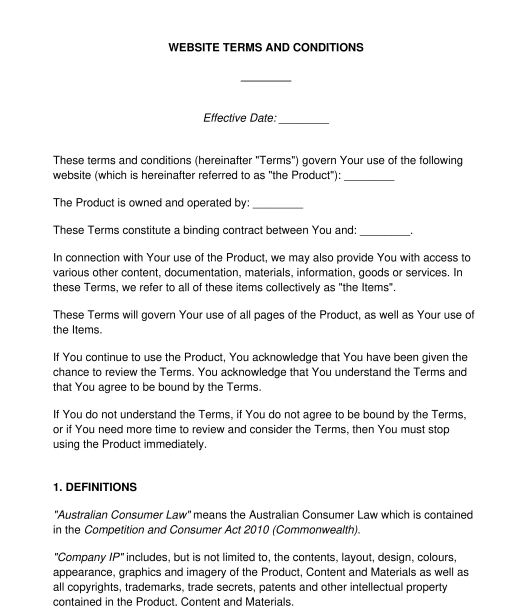 27/10/2025
27/10/2025

Answer a few questions and your document is created automatically.

Your document is ready! You will receive it in Word and PDF formats. You will be able to modify it.

 27/10/2025
27/10/2025
 Word and PDF
Word and PDF
 10 to 15 pages
10 to 15 pages



These Terms of Use are a set of rules about use of a website or application. They set out how users may use the site or application, and what they can and cannot do on the site or application. For example, if a user posts offensive or defamatory content on a website, the owner of the site will want to have terms and conditions to fall back on which clearly state that the owner of the site does not permit or take responsibility for that offensive content, and that any liability (such as a defamation claim) should therefore sit with the user. In addition, the owner of the site may want to have the ability to terminate the user's account - and this also will need to be explained in the Terms of Use.
Terms of Use for a Website or Mobile Application are one of several documents which are required for online businesses. These Terms of Use set out the rules for using a website (or app). They deal with the general use of the website, rules around how the website may (and may not) be used, who owns the intellectual property, and disclaimers for the information contained on the website.
On the other hand, a set of Terms and Conditions for Sale of Goods Online deals specifically with the sale of goods on the website or mobile application. It covers things like prices, payment terms, shipping, warranties, refunds, and taxes.
No, but it is strongly recommended that all websites or apps have a set. These Terms of Use can help to limit the liability of the owner of the platform, and to protect their website from various online threats such as IP theft.
Terms of Use do not expire so they can remain on the website or application indefinitely. However, they should be regularly reviewed and updated to make sure they are up to date with current laws and reflect the current structure of the website or app.
Once the Terms of Use have been completed, they can be published on the website or mobile application, in a location that is easy for users to find. For example, many websites include a link to their Terms of Use in their website footer.
It is preferable to make sure that users actively agree to the Terms of Use. For example, users might be asked to click an "I agree" button before accessing the website or app, with that button sitting next to an active link to the text of the Terms of Use.
They can be. But if a user is able to argue that they never agreed to the Terms of Use, then the Terms may not be binding.
Therefore, to maximise the likelihood of the Terms of Use being binding on users, the owner of the website or app should make sure that users are actually informed of the Terms of Use, and actively agree to them. Active agreement means making the user perform some kind of positive action to confirm their agreement (such as clicking a button which is located right next to an active link which takes users to the Terms of Use).
These Terms of Use should include:
Terms of Use for a website or for a mobile application, once accepted by a user, constitute a contract between the website or application owner and the user. As such, ordinary principles of contract law apply. These principles are derived primarily from common law.
In addition, depending on the nature of the website (and in particular, whether the goods or services being sold are for personal or domestic use), the Australian Consumer Law may also apply.
The owner of the website or application has the opportunity to nominate the governing law for the website. However, if users can access the site from other locations, then laws from other jurisdictions may also become relevant. This document is prepared for use in Australia and other legal systems have not been considered.
As of 25 May 2018, the European Union General Data Protection Regulation (GDPR) contains data protection requirements that may apply to Australian businesses.
Australian businesses (regardless of size) may need to comply with the GDPR if they have an establishment in the EU, if they offer goods and services in the EU, or if they monitor the behaviour of individuals in the EU.
These terms and conditions do not deal with the GDPR. They are only designed for compliance under Australian law. We have a GDPR compliant set of terms and conditions (which operate under UK law rather than Australian law), available on our UK site.
Further information about how the GDPR may affect Australian businesses is available through the Office of the Australian Information Commissioner.
You fill out a form. The document is created before your eyes as you respond to the questions.
At the end, you receive it in Word and PDF formats. You can modify it and reuse it.
Guides to help you
Country: Australia